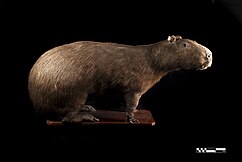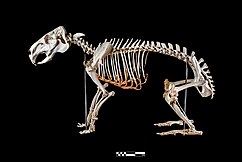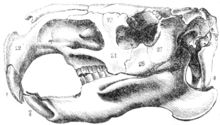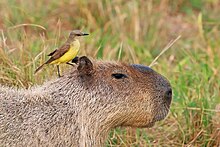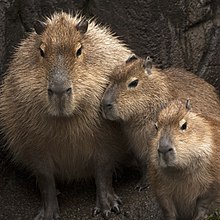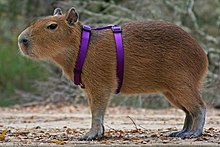Hydrochoerus hydrochaeris
The capybara, capybara or capybara (Hydrochoerus hydrochaeris) is a species of rodent in the family of the cavids, native to South America. It is the largest and heaviest living rodent in the world, of the genus Hydrochoerus. The only other extant member of that genus is the lesser capybara (Hydrochoerus isthmius). Its close relatives include guinea pigs and mocós, and it is more distantly related to the agouti, chinchilla, and coypu. It inhabits wetlands and dense forests and lives near bodies of water. It is a very social species and can be found in groups of up to one hundred individuals, but it usually lives in groups of ten to twenty individuals. The animal is hunted for its meat and fur and also for the fat from its thick, greasy hide.
Common name
One of its common names, capybara, comes from the Guarani "kapiÿvá" or "kapi'yva", meaning 'lord of the grass' or 'grass eater', respectively. In the Tupi language, the term is ka'apiûara, meaning 'he who eats thin leaves', or 'grass eater'.
The words that make up the scientific name, both hydrochoerus and hydrochaeris, come from the Greek ὕδρω (hydro "water") and χοῖρος (choiros "pig"), coming to mean 'water pig'.
It is often referred to in many ways that vary by country or region:
- Argentina: carpincho, chancho de agua, capibara.
- Bolivia: carpincho, capibara, capihuara, capihuara.
- Brazil: capivara.
- Colombia: chigüiro, jomo (in the eastern plains), paqui, ñeque (north of Colombia), ponche.
- Ecuador: carpincho, capincho, capibara.
- Mexico: capibara, coconut dog.
- Panama: poncho, capibara.
- Paraguay: carpincho, capincho, capibara, kapi'yvá.
- Peru: ronsoco, capibara, carpincho.
- Uruguay: carpincho, capincho, capibara.
- Venezuela: chigüire piro-piro.
- El Salvador: capibara.
Description
It has a heavy, barrel-shaped body and a small head, with reddish-brown fur on the upper body that fades to yellow-brown. In its lower part, fur with dots or petechiae is usually found on the back. It can grow up to 1.30 m long and weigh 65 kg. It has slightly webbed feet, and similar to other cavids, it lacks a tail and has twenty teeth. Its hind legs are somewhat longer than the forelegs, and the snouts are blunt, with eyes, nostrils, and ears on the top of the head. Females are slightly heavier than males.
Her karyotype has 2n = 66 and NF = 102, which means she has 66 chromosomes with a total of 102 arms.
Body and fur
The body, which lacks a tail, is massive and round in shape, with a thick trunk and four short legs. The front legs have four toes and the hind legs have three, exposed radially. The thick, hoof-like fingers have small webbing that joins them interdigitally. Capybaras reach a length of 1 to 1.30 m and a height at the back of 50 to 60 cm; females are usually slightly larger than males. The average weight is 50 kg in males and 61 kg in females; however, the actual weight can vary between 27 and 65 kg. The extinct Neochoerus sulcidens was significantly larger.
The coat is long and wiry, but in places so fine that skin can be seen through it. This makes them prone to sunstroke, and to avoid it, they roll in the mud to protect their skin from the sun. The coloration ranges from reddish-brown to gray on top, while the underside is pale. yellow brown. Some specimens have black spots on the face, on the outer side of the legs, and on the back. The length of the hair goes from 30 to 120 mm.
Head and teeth
They have a remarkably broad and large head. Relative to the closest relatives of the capybara, the snout is larger and rounder, while the nostrils are small and widely separated. In male specimens, the tip of the snout is bald and endowed with a prominence corresponding to the olfactory gland. The ears are small and round, while the eyes are located on the sides and are also small. As with many animals that lead a partially aquatic lifestyle, the capybara's eyes, ears, and nostrils are located on the top of the head, so that when they come out of the water to breathe or observe their surroundings, they hardly protrude from the surface.
The dental formula of this animal is 1-0-1-3; which means that each half of the jaw presents an incisor tooth, a premolar and three molars, with a total of twenty teeth. The white incisors are endowed with a groove and, as in all rodents, they are enlarged and transformed into incisors. rootless. Behind the incisors there is a space called a diastema. The posterior teeth are also rootless and have a complex morphology; they consist of heart-shaped or bar-shaped prisms of dental enamel, which are separated by layers of cementum. Like other rodents, capybaras' molar and incisor teeth are constantly growing to compensate for the continual wear and tear caused by eating so much grass.
Distribution and habitat
Its enormous range includes almost all of South America east of the Andes in the Orinoco, Amazon and Río de la Plata basins; covering from eastern Venezuela and Guyana to Uruguay, Paraguay and much of northern Argentina, mostly in the province of Corrientes.
They can live in different types of habitats, but they show a preference for a few in particular. They are usually found near lakes, rivers, marshes or mangroves. They also need firm ground to sleep on, ideally with thick vegetation for protection. To feed themselves they have no problem entering the savannah and grasslands. The highest population density of capybaras is found in the extensive humid areas of South America, such as the Pantanal, or the Llanos region in the north of the continent, bathed by the Orinoco River. They live mostly on the plains, but also inhabit altitudes up to 1300 m s. no. m.. Compared to other animal species in South America, capybaras tolerate habitat changes caused by human activity quite well, and can also survive in areas converted to plantations or pastures.
Behavior
Activity
Capybaras are primarily crepuscular animals. They spend the heat of the day in holes in the mud or in the water. To sleep, they hide in thick vegetation; they don't need any cave. Instead, in areas where they are disturbed by human activities, they change and adopt a nocturnal lifestyle.
If a capybara senses danger, it warns the others with a short bark, and immediately they all trot at horse-speed to safety in the water. They can dive and stay underwater for up to five minutes, and are capable of swimming with their entire bodies submerged except for their ears, nostrils, and eyes. Charles Darwin described the behavior of this species thus:
During the day they are tended between aquatic plants or go quietly to feed the grass of the plain. Vistos from a distance, their passage and their color make them look like the pigs; but when they are seated, watching with attention all that happens, they again acquire the look of their congeners the cavias and the rabbits.
Social Life
They live in groups, which can be made up of a couple and their young, or by a larger group of adults. The size of the groups varies between six and twenty animals. In some rare cases, solitary specimens can also be seen, almost always adult males.
The size of the groups and their lifestyle depend on the season of the year and the habitat. During the rainy season, they spread over a large region, so that the size of the group decreases. During this season, they eat a lot and accumulate a reserve of fat. The breeding of the newborns also occurs mainly during the rainy season. During the dry season, many specimens gather around the largest rivers and lakes, forming larger groups. During this season, mortality is notably higher, as hunger and disease increase and with the disappearance of the plants that serve as protection, capybaras are more vulnerable to attacks by predators. Researchers from Venezuela indicate a group average of 5.6 animals during the rainy season and 15.9 in the driest month of March. In prolonged periods of dryness, large groups of up to 100 individuals can form, which gather near the remaining waters. Although these groupings are unstable and do not last long.
Each group, both familial and mixed, is led by a dominant male, who normally holds this position for many years. Then come one or more females with their young and sometimes the subordinate males are also part of the group. The hierarchy is usually stable and well marked between both males and females, and is established through partly aggressive fighting.
Each group inhabits a territory of between 5 and 17 hectares, although the animals usually remain within a region of about 10 hectares, which they defend against incursions by other specimens of the same species. They mark the territory by means of scent glands; in males they are located on the nose, and both sexes have them in the region of the anus (anal glands).
They communicate with each other through a variety of vocalizations. Among them are a purring sound similar to a cat's purring, indicating submission, an alarm cry similar to a dog's barking, a clicking manner that expresses happiness, shrill hisses and growls.
Food
Diet consists mainly of terrestrial grasses, occasionally supplemented with aquatic plants. Sometimes they enter plantations and feed on, for example, sugar cane, watermelon or corn. The widespread belief that fish are also part of the capybara's diet is false. They have an extremely efficient digestive system that allows them to subsist on a diet 75% of which is made up of only four to six plant species, and then they stop eating them for a period of time, allowing the plants of these species to recover. before eating them again.
Its digestive system has various adaptations to its diet, such as a longer intestine and an enlarged sac-like cecum. In a similar way to other rodents, such as guinea pigs, or lagomorphs, capybaras practice coprophagy or occasional ingestion of excrement. Feces are a soft, sticky form of excrement, which is fermented by special bacteria in the cecum, and is swallowed again immediately after excretion. In this way, they can extract the maximum nutrients from their cellulose-rich foods. When the droppings are finally expelled a second time, they are oval and dry.
Capybaras, like guinea pigs, cannot make vitamin C on their own, so they must obtain it through their diet. In some captive specimens, which had obviously been poorly fed, cases of scurvy have been observed.
Playback
When in heat, the female's scent subtly changes and nearby males begin to chase her. In addition, the female alerts males that she is in heat by whistling through her nose. During mating, the female has the advantage and the choice to mate. Capybaras mate only in the water, and if a female does not want to mate with a certain male, she will either dive in or out of the water. Dominant males are very protective of females, but are usually unable to prevent some of the subordinates. mate. The larger the group, the more difficult it is for the male to keep an eye on all the females. Dominant males ensure significantly more matings than each subordinate, but subordinate males, as a group, are responsible for more matings than each dominant male. Capybara sperm live longer than other rodents.
Mating can take place at any time of the year, but most births are usually in the rainy season (April to May in northern South America and October in southern South America). Generally, each female calves once a year, but if weather conditions are favourable, she may calve twice. The gestation period lasts about 110 days in the northern subspecies and about 150 in the southern one. Capybaras are multiparous, and each birth is made up of an average of four young, but it can vary between one and eight. The birth occurs on land and the female joins the group a few hours after giving birth to newborn capybaras, which join the group as soon as they are mobile. After a week, the young are able to eat grass, but continue to suckle - from any female in the group - until they are weaned at around 16 weeks. Young form a group within the main group. Both sexes become sexually mature at approximately twenty-two months of age. Alloparentality has been observed in this species. Breeding peaks between April and May in Venezuela and between October and November in Mato Grosso, Brazil.
Its longevity in the natural state varies between eight and ten years, while specimens in captivity can reach twelve years.
Predators
Their most important natural predators are felids such as jaguars, pumas or ocelots, and also jungle foxes, anacondas and caimans often attack them frequently. Sometimes the hatchlings fall prey to birds of prey such as harpies.
Relationship with humans
Indigenous South American peoples already hunted them for meat, took advantage of the skin and used the incisors for decorative purposes. They also have a role in the mythology of these peoples. In the traditional beliefs of the Yanomami (ethnic group from Venezuela and Brazil) "each newborn has a double in the form of a chigüiro or a tapir who provided him with vital force, while if the animal died the person also". In the Venezuelan plains it is common to domesticate them or raise them for human consumption.
Saddlery
They are hunted for their skin and meat. In the (River Plate) nations of Argentina and Uruguay there are professional hunters known as "carpincheros", who hunt this mammal for commercial purposes. There are also very many people who hunt them for their own use, and their skin is usually used as a leather, light brown in color and with small lighter spots, which is especially appreciated for saddlery in Venezuela, Paraguay and in Argentina for the manufacture of gloves, footwear, belts and leather jackets. Bridles, saddles and whips are also made from it. From the fat of the capybara its oil is extracted, which is used as a medicine of natural origin.
Food
Its meat is rich in ectoparasites (95%) and endoparasites (100%); considered by its consumers to be lean, with a strong odor and of good quality, it has a prevalence of leptopirosis of 45.5% in young specimens and even higher in grown ups; It is low in fat and has a very low cholesterol content, as is typical of the meat of rodents such as rats. It is consumed especially in the plains of Colombia and Venezuela, where it is salted after drying, marinated and eaten. on abstinence days. It is a widespread belief in South America that there would be an old official ecclesiastical document that would classify it among the "fish", due to its aquatic way of life, its smell similar to that of fish and its slightly hairy skin, although it is a legend., and there are similar legends in other religions on Earth about other aquatic animals, such as beavers.
In Argentina, Brazil and Uruguay, the meat is mainly used to make sausages. In Argentina, there are even commercial farms of the species in some provinces along the river coast. Coincidentally, Argentina (22%) has the second highest incidence of leptopirosis in Latin America per 100,000 inhabitants. In the region of the Llanos de Colombia and Venezuela, because of the multiple uses of this animal, there are already attempts to breed capybaras, similar to the Argentine experience; on farms for commercial purposes.
Around 2020, in Argentina the capybaras returned and entered urbanizations in the province of Buenos Aires, specifically in the Nordelta neighborhood, in the town of Tigre. The neighborhood, a luxury real estate development, was built on wetlands around the Paraná River, the native territory of animals. However, artificial lakes and houses with parks create an ideal environment for rodents, which have returned to their land and reproduced considerably, causing minor problems for the neighbors. Faced with complaints from the neighbors, support for the capybaras became a viral phenomenon on social networks and the media, with environmental groups strongly supporting the wetland law, and some sectors of the press accusing the Kirchnerists of using to the capybaras as a shock force.
Capybaras in zoos
Capybaras have adapted well to urbanization in South America. They can be found in many zoo and park areas, and can live for 12 years in captivity, more than twice their lifespan in the wild. Capybaras are docile and often allow humans to pet and feed them, but this is generally discouraged. physical contact, as their ticks can be vectors of Rocky Mountain spotted fever.
The European Association of Zoos and Aquariums asked Drusillas Park, in Alfriston, Sussex, England, to maintain the capybara stud book to control captive populations in Europe. The stud book includes information on all capybara births, deaths, and movements, as well as their parentage.
Systematics and taxonomy
The capybara and the lesser capybara belong to the Hydrochoerinae subfamily together with the mocós. Living capybaras and their extinct relatives were formerly classified in their own family Hydrochoeridae. Since 2002, molecular phylogenetic studies have recognized a close relationship between Hydrochoerus and Kerodon, supporting placing both genera in a subfamily of Caviidae. Paleontological classifications previously used Hydrochoeridae for all capybaras (living and extinct), while using Hydrochoerinae for the living genus and its closest fossil relatives, such as Neochoerus, but more they have recently adopted the classification of Hydrochoerinae within Caviidae.
The fossil ancestors of Hydrochoerus hydrochaeris are represented by various genera from the Upper Miocene. The most primitive forms are classified within the cardiaterine subfamily, which although paraphyletic, the most primitive representatives The group's recent developments developed from them. The subfamily of protohydrokerines is known from the Pliocene, with the single genus Chapalmatherium (also known as Protohydrochoerus). The skull of these animals was twice as large as that of H. hydrochaeris present, and its limbs were also considerably longer. The hydrokerine subfamily, to which H. hydrochaeris, appeared in the Late Pliocene. All the fossil remains of giant rodents come from the American continent.
As for the correct scientific name of the genus, there is a long controversy between the name Hydrochoerus, created by Brisson in 1762, and the name Hydrochaeris, established by Brünnich in 1772. Both names come from the Greek words hydros (water) and choiros (pig). The name given by Brisson was rejected for a long time, since it did not conform to the norms of binomial nomenclature. Although the International Commission on Zoological Nomenclature declared the name Hydrochoerus valid because of its wide use, so Hydrochoerus hydrochaeris is the correct scientific name.
Conservation and threats
Many suitable habitats for this species are in regions heavily used for grazing. As humans prepare water sources for their animals, minimize the number of carnivores through hunting, and as cattle keep the grass short, there has been an increase in their population in many areas. Censuses of bovine estates in the Llanos region revealed a density of Hydrochoerus hydrochaeris between 50 and 300 per km². Grazing land owners persecute them, especially during the dry season, as they believe that capybaras devastate their animals' food. However, many people consider that the killing of this animal by these landowners is cruel, since it is done with clubs, shots or with hunting dogs.
Mainly in Brazil, there are people who believe it is good to hunt them because of the damage they supposedly cause to industrial crops; such as soybeans and millet, and especially in rice plantations, where they could cause considerable devastation. In these places they are considered a pest.
In regions where they are hunted in commercial quantities, such as the Colombian-Venezuelan border regions, sightings by locals are already rare.[citation needed] In other nations, such as Peru, their numbers have been drastically reduced or they have disappeared as a result of their voracious consumption or the disappearance of their habitat.[citation required] Although they are generally abundant and have a wide distribution in other regions of the South American continent, they are not considered a threatened species for that reason.
Domestication
- Argentina: These wild animals cannot go through a domestication process, not only because of the alteration of the ecosystem, but also because the possession of wildlife is punishable by Law No. 22.421
- The United States: Although illegal in some states, capibaras occasionally remain pets in the United States.
Literature
The chigüiro, as it is known in Colombia, became popular thanks to the children's books of the Colombian writer Ivar Da Coll (b. 1962). Since then it has established itself as a classic of picture books in Latin America with the Chigüiro saga (Norma, 1987), made up of six stories without words (Chigüiro chistoso, Chigüiro finds help, Chigüiro travels by goat, Chigüiro and the bathroom, Chigüiro and the pencil and Chigüiro y el palo). Chigüiro leaves).
The chigüire, as it is called in Venezuela, has also become a popular figure with the creation of a humorous journalism portal focused on political criticism: El Chigüire Bipolar.
El Capybara also inspired a literary work that bears the name, El Crepúsculo de los Capybaras, in which the odysseys of the fictitious leader of a herd known as Capigrande and the different difficulties that the group of Capybaras is going through are related. consecrate itself as the most sociable of nature.
In popular culture
Argentina
The capybara became popular as a humorous character during 2020, partly due to the preventive and mandatory social isolation measures established in the SARS-CoV-2 pandemic. The confinement allowed the capybaras to begin to frequent more urbanized areas, which they previously avoided, and people recorded their activities, particularly appreciating their docility and elegance.
In 2021, residents of the Nordelta residential complex filed complaints about the increase in the capybara population. The complaints were disseminated through various social networks, leading to a critical reaction from public opinion.
The Nordelta neighborhood is one of several private residential complexes built on wetlands in the Tigre district, therefore one of the most controversial. Its construction displaced the ecosystem, and has generated flooding and social conflict in the surrounding residential area. From this, and given that capybaras are part of the native fauna, humorous images proliferated that made the capybara a symbol of resistance. sociocultural and environmental.
Uruguay
In Uruguay, the effigy of the capybara circulates throughout the country on the 2-peso coin, it belongs to the collection of coins with the effigies of the native fauna of the country. There are also typical dishes such as roasted capybara blanket and milanesas obtained by hunting this animal, and in homes the meat is seasoned and spiced to taste to prepare the dishes.
Contenido relacionado
Allolepis texana
Struthiomimus altus
Deinonychus antirrhopus
